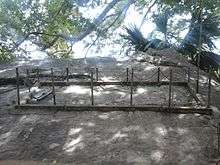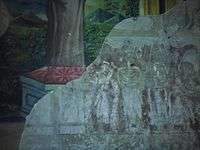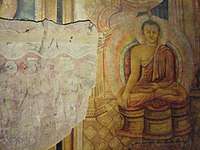Paramakanda Raja Maha Vihara
| Paramakanda Raja Maha Vihara | |
|---|---|
| පරමාකන්ද රජ මහා විහාරය | |
 | |
| Basic information | |
| Location | Paramakanda, Anamaduwa, Sri Lanka |
| Geographic coordinates | 07°55′N 80°00′E / 7.917°N 80.000°ECoordinates: 07°55′N 80°00′E / 7.917°N 80.000°E |
| Affiliation | Buddhism |
| District | Puttalam |
| Province | North Western Province |
| Heritage designation | Archaeological protected monument (1 November 1996), and (23 January 2009) |
| Architectural description | |
| Architectural type | Buddhist Temple |
| Architectural style | Cave temple |
| Founder | King Walagamba |
Paramakanda Raja Maha Vihara (Sinhalese: පරමාකන්ද රජ මහා විහාරය) is an ancient Buddhist temple in Puttalam District, Sri Lanka. The temple is located in Paramakanda village approximately 4 km (2.5 mi) distance from the Anamaduwa town. The site has been formally recognised by the Government as an archaeological site in Sri Lanka.[1] The designations were declared on 1 November 1996 and 6 June 2008 under the government Gazette numbers 948 and 1586.[2]
The temple

It is believed that the history of Paramakanda temple goes back to the reign of king Walagamba (103 BC and c. 89–77 BC).[3]
The Vihara complex mainly consists of two terraces. The lower terrace includes the Stupa, Bodhi tree, dripledged rock caves, Bikkhu dwellings, the main image house and the bell tower. Another small image house, a Stupa and a rock carved foot print of Buddha are found in the upper temple premises.[4] The main image house of the lower terrace is adorned with paintings and sculptures belonging to the Kandyan tradition as well as the new art style.
Inscriptions


Few rock inscriptions have been discovered in the temple premises. One inscription has been incised on the vertical face of a rock at one side of a small pool of water.[5] Another inscription is found on a rock near Bo tree and belongs to the 7th century A.D.[6]
The inscription near the pool
Period: 1st century AD, Script: Early Brahmi, Language: Old Sinhalese
Content: "The inscription mentions about the cistern of the chief daring mariner Tissa, the son of the chief Abhaya"
See also
References
- ↑ "Protercted Monument List 2012-12-12" (PDF). Department of Archaeology. 12 December 2012. Retrieved 27 March 2016.
- ↑ Gazette 1586 & 23 January 2009, p. 107.
- ↑ "ඓතිහාසික පරමාකන්ද රජ මහා විහාරය ජරාවාස වෙලා". Dinamina. Associated Newspapers of Ceylon Limited. 19 April 2017. Retrieved 1 March 2018.
- ↑ "Paramakanda Cave Temple". srisalike.com. Retrieved 19 July 2015.
- ↑ Parker, H. Ancient Ceylon. Asian Educational Services (1981). p. 438. ISBN 9788120602083.
- ↑ Dias, Malini (1991). Epigraphical notes (Nos 1 -18). Colombo 7: Department of Archaeology. p. 72.